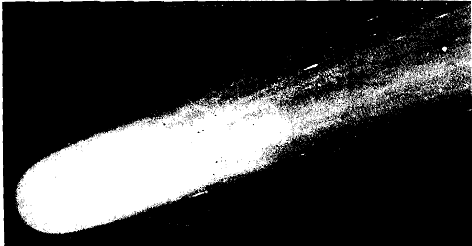A Cloud Made of Comets
The cold outer areas beyond Pluto are the regions of comets, those visitors that dash, around the Sun, seldom to be seen again. Comets are of grei3t interest because they are the relics of the early history of the Solar System. When solar matter was churning and the Sun had just been ignited, its heat drove ,the lighter elements into the outer reaches of the Solar Syst.em. Hydrogen, oxygen, nitrogen and carbon collected into something like snowy cotton balls and they still float as a "cloud", at a disiance of 100.000 times the distance of the Earth from the sun! This thin cloud of comets reaches out to a distance halfway to the nearest star, i.e. almost a few billion kilometers. Comets are made mainly of 'ices', that is ordinary water ice mixed with frozen gases such as methane, carbon dioxide and ammonia.
The ices are mixed with specks of dust that makes them look like dirty snowballs. Billions of comets stay in their great cloud, moving slowly in enormous orbits around the Sun. While still in this cloud, comets do not shine. Once in a while the gravity of a passing star disccrbs this cloud. A few comets then move into interstellar space and are lost to the Solar System. Others move towards the Sun. Seen from the Earth, the comets shinc more brightly than anything in the sky, except the Sun and the Moon. You may wonder how dirty looking snowballs turn into bright long-tailed comets. As a comet moves towards the Sun, its surface is warmed by the strengthening sunlight. Some of its frozen material turns into gas, forming a rapidly growing cloud called its head or coma, around its centre. On getting nearer to the Sun, more gas evaporates and its head becomes bigger and brighter. Also, a brilliant tail, made of dust and gas, is pushed out of the head by the pressure of the sunlight and the solar wind.
This tail extends in a direction away from the Sun. If comets pass very close to the Sun, they acquire enormous speeds, more than a million kilometers per hour, and move off into space with their tails pointing ahead. Most comets depart on long elliptical orbits, billions of kilometres into deep space, ana remain there for thousands of years. But a few do not escape from the Sun so easily. If they happen to pass near a large planet, particularly Jupiter, its gravitation pushes them into short-period orbits around the Sun. One of the most famous comets is Halley's comet which returns once every 74 to 79 years (Fig.). It was last seen in 1986. Sometimes fragments from the comets fall on the Earth producing meteors. Comets returning repeatedly lose their gases each time. When all their ices melt, comets disintegrate, leaving a stream of small particles that spreads out thinly and loses its identity.
